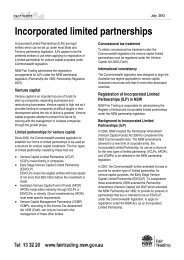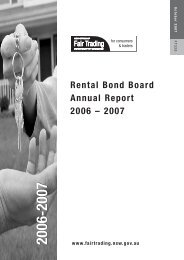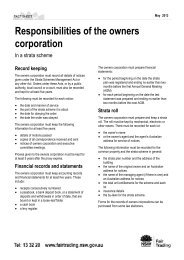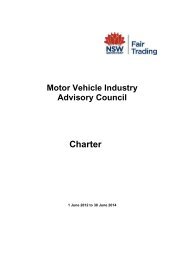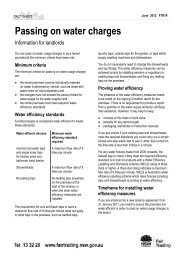High front guttering advisory committee report - NSW Fair Trading ...
High front guttering advisory committee report - NSW Fair Trading ...
High front guttering advisory committee report - NSW Fair Trading ...
You also want an ePaper? Increase the reach of your titles
YUMPU automatically turns print PDFs into web optimized ePapers that Google loves.
this point, it is worth reiterating that BCA performance requirements are silent on issues such as<br />
gutter durability, maintenance and gutter cleaning, whilst Deemed to Satisfy options such as<br />
AS3500.3/3500.5 provide greater detail on these issues mainly by way of guideline “notes” or<br />
“informative” text. In terms of method, it would seem that AS3500.3 often provides more<br />
conservative results when calculating the likes of downpipes compared to the design method used in<br />
the BCA under “Acceptable Construction Practice” (refer to Section 7.3) for supportive information<br />
on this point). In terms of detail, the BCA’s “Acceptable Construction Practice” occupies only 5 pages<br />
of content, whilst the likes of AS3500.5 occupies 32 pages in the roof drainage design and<br />
installation sections, plus another 37 pages in associated Appendices “C” to “H”.<br />
Such issues are important in so far as delineating what is directly relevant to assessing a “systemic<br />
problem” relative to minimum BCA performance requirements, versus Deemed to Satisfy options<br />
that may offer higher standards in certain design features or may become immersed in prescriptive<br />
detail that may not be directly relevant to the achievement of minimum performance requirements.<br />
Alternative Solutions<br />
In addition to the above, alternative solutions are also possible under the BCA and can be developed<br />
to improve cost-effectiveness, improve constructability, incorporate innovation, or address anything<br />
different to standard practice. No specific solutions of this nature were identified or presented to<br />
the Committee during its Review, though it became apparent that certification of a <strong>guttering</strong><br />
installation by a hydraulic engineer (or other appropriately qualified expert) may be acceptable as an<br />
Alternative Solution, under the assessment methods mentioned in Figure 1 (including expert<br />
judgement under BCA Clause 1.0.9). Here, advice from the Building Professionals Board indicates<br />
that the Principal Certifying Authority (PCA) on a given project has the right of acceptance or<br />
rejection of such a certificate, thus reducing the level of confidence that designers and contractors<br />
may have in using this approach as a common means of proving compliance 1 .<br />
Notwithstanding this, there is still potential for this approach to be used where needing to prove<br />
compliance, especially where Deemed to Satisfy solutions have been partially but not fully followed,<br />
and in such cases expert input may be appropriate concerning compliance with minimum BCA’s<br />
performance requirements.<br />
Closing Thoughts on the Contextual Importance of the BCA<br />
In general and as an adage to the above discussion, it is the Committee’s opinion that the<br />
importance of the BCA’s performance driven approach and the structure it provides for multiple<br />
methods of proving compliance, has often been overlooked in the debate about systemic problems<br />
with high <strong>front</strong>ed <strong>guttering</strong>. The debate has instead tended to dwell on the prescriptive<br />
requirements contained in specific Deemed to Satisfy solutions- such as in AS3500.3/3500.5 and the<br />
Acceptable Construction Practice part of the BCA. Though issues pertaining to these documents<br />
need to be resolved and to this end are discussed in detail later in this <strong>report</strong>, over emphasis on<br />
1 One variant on this theme concerned the issuance of ”compliance certificates” which PCAs must accept but<br />
can only be provided by a certifier appropriately accredited by the Building Professionals Board (BPB). It was<br />
advised by the BPB that this is not a commonly used option because of the lack of appropriately accredited<br />
certifiers in the hydraulic engineering field and because of risk management reasons (as perceived by those<br />
issuing the “compliance certificates”).<br />
15





